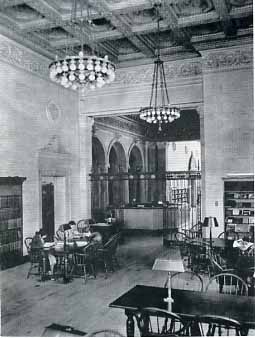
B. F. Jones Memorial Library. The Adult Reading Room as it appeared in 1930.
Return to Milestones Vol. 6, No. 1
The B. F. Jones Memorial Library celebrated its 50th anniversary during a three day celebration on May 16, 17, and 18, 1979. Throughout the past 50 years, the library has been a haven of resources and information for the citizens of Aliquippa.

The library's beginning was a result of the Aliquippa Women's Club in 1919. These women worked diligently to arouse interest, solicit, and collect subscriptions and by June they organized a Free Library Association. The town council provided a room on the second floor of the Municipal Building including shelves, tables, light, heat, and janitor service. In October the librarian arrived, supplies were ordered and books were donated by the school children, the townspeople, their friends, and everyone interested. After the gifts had been received, a list was sent to New York and Philadelphia to see if other books could be bought second hand. By November these books were catalogued and on January 3, 1921 the library was opened to the public with 1,650 books on the shelves.
According to their records, eight months after the library opened, a total of 1,600 people borrowed 19,235 books and 4,600 people used the library for reading or the use of reference materials.
Meanwhile, the town of Aliquippa, known as Woodlawn in the early 1900's, was a prospering business district due to the expansion of Jones & Laughlin Steel Corporation. The mill had outgrown its Pittsburgh plant and a large site in Aliquippa was selected for the necessary expansion. The growth of J&L Steel gave the thriving town of Woodlawn a promising future.
The man responsible for this expansion was Benjamin Franklin Jones, co-founder of J&L Steel Corporation. Jones, born August 8, 1824, in Claysville, Washington County, Pennsylvania, lived in New Brighton for four years while attending the New Brighton Academy. At the age of 18 he traveled to Pittsburgh in hopes of making his own way in the world. From there he worked his way into the steel business. B. F. Jones was married in May of 1850 to Mary, daughter of John McMasters, a prominent and esteemed citizen of Allegheny County. They had five children of whom Benjamin Franklin Jr. became his father's business associate and his successor in the corporation.
B. F. Jones Sr. died suddenly on May 19, 1903 at the age of 79, after being active and forceful throughout his entire life.
On November 9, 1926, Mrs. Elizabeth M. Horne, daughter of B. F. Jones Sr., wrote a letter to the Borough Council of Aliquippa expressing concern about the limited library quarters for a growing community. The library at that time was still in the Municipal Building. She further stated that, subject to certain conditions, she would have erected for the people of Woodlawn a free, public and non-sectarian library. The conditions to be met for this project were that the Borough of Woodlawn would adequately support and maintain the library and that the property would be controlled and administered by a representative Board known as the Board ot Directors of the B. F. Jones Memorial Library. The Borough accepted the offer on November 15, 1926 and the presentation and dedication of the library on February 1, 1929 was a memorable day for the people of the Woodlawn community.
The building itself has quite a unique architecture, Built by master craftsmen and artists, the library was conceived in the style of the Italian Renaissance.
The exterior is made of gray Indiana limestone. The frieze, frequently used as a decorative feature, was omitted and a bronze cheneau was used instead.
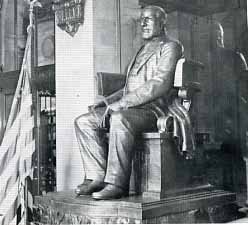
Upon entering the library, one outstanding feature is a bronze statue of B. F. Jones. It was sculptured by Robert Aiken, N. A., of New York. The statue sits on a block of green Vermont marble. Another feature of the lobby is the side walls made of Kasoda stone, a Minnesota marble which has never been used in this district. Indirect lighting is used throughout the library as well as wall medallions made of imported Italian marble. These medallions are copies of the famous Andrea della Robbia Bambini found on the porch of the Foundling Hospital in Florence, Italy.
The interior continues in the Renaissance tradition. The decorative ceilings are cast in plaster and colored. The ceiling in the reference room is cast plaster, made to simulate wooden beams and colored to imitate gum wood.
Floors in the library are real Travertine and the doorways are of stone cast from marble chips and carved according to the architect's design.
Although several rooms have been re-arranged inside the library, the original layout and design of the building still exists. The library includes reading, periodical, and reference rooms, offices, balcony and lobby. Downstairs is the children's room, work room, kitchen and staff rooms.
Detail is monumental in the library. Entrance to the reference and reading rooms is through bronze and iron gates which simulate the miniature altar screens in European cathedrals. The office, previously the children's story hour room, is prided by its leaded stained glass windows, depicting nursery rhymes, and its Florentine doorway which leads to a great conical Renaissance fireplace.
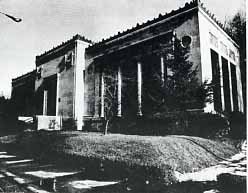
In the span of its fifty year existence, the B. F. Jones Memorial Library has directed its services and its programming to meet the needs of an industrial community composed of various ethnic groups and their diverse cultures. In early times the library helped the foreign-born adjust to the main stream of American life. The library held programs to try to bridge the gap between foreignborn parents and their American-born children.
During the depression, the library thrived, reaching its peak of borrowers. During World War 11, circulation and library users declined. However, Red Cross and first aid classes were held and the Exhibition Room downstairs, now the children's room, was designated as an air raid shelter.
The library's education role includes attention to the library as an extension of the home and neighborhood. Children's programs are abundant with story hours, craft sessions, and reading programs for children of all ages. Parents are encouraged to join their children for the story hour sessions as an essential contribution to the child-parent relationship.
The B. F. Jones Memorial Library is the District Center for the Beaver County Federated Library System. The Aliquippa District plays a vital role as a mini-resource center and as a consultant agency for local libraries. This county-wide system has resulted in a dramatic increase in registrations and use of library materials such as audio-visual films and equipment, cassettes, 8-track tapes, records, framed art, puzzles, and, of course, row upon row of fiction and non-fiction books.
The B. F. Jones Library is also one center for the Adult Literacy Project which is structured to help the functionally illiterate to cope with the needs of their daily lives in occupation, consumer economics, problem solving, interpersonal relations and communications. The Carnegie Free Library in Beaver Falls is also a center for the Adult Literacy Project. Plans are being made for the Beaver Area Memorial Library to be the third center.
The B. F. Jones Memorial Library, serving as the District Center, promotes outreach services for senior citizens and those confined to nursing homes in the area.
Such programs relate to the library's objectives toward a continuous learning process through the use of books and related materials. Those who are proud of their library may become more supportive by becoming active members of the Friends of the Library or by becoming a volunteer.
The Carnegie Free Library of Beaver Falls holds the distinction of being Beaver County's first public library. A public library association comprised of concerned citizens was in existence as early as 1883. Their goal was to establish a free public library in Beaver Falls.
The association, in conjunction with students from Geneva College, set up a series of six lectures held in 1884. Proceeds from the first lecture yielded $60.86 for the association. Quoting from a lecture given by M. L. Knight, superintendent of schools, we read: "With $60.86 in the treasury, visions of a magnificent, brownstone, four-story building rose before our eyes in the misty future."
Three results emerged from this effort. First, the People's Library Association was formed with Julius Kurtz as president. In addition, the lecture series continued to flourish for many years after the library opened. Finally, the most important result, was a circulating library that was opened on December 31, 1884 in Will Mitchell's Grocery at 13th Street and Seventh Avenue. A total of 100 books were loaned at a fee of $1.00 for two years.
Money accumulated very slowly. By 1887 there was only $258.72 in the treasury. The association decided to have an industrial display, which brought in $700 profit.

In January 1899, a committee composed of W. H. Morrison, J. F. Merriman, H. W. Reeves and F. F. Brierly was appointed to contact Andrew Carnegie and ask for a donation with which to build a library. After considerable correspondence a letter was finally received in which Carnegie offered a gift of $50,000 for the purpose of erecting a building suitable for a library.
After changing the building site several times, it was decided to build the library on the lot on the corner of 13th Street and Seventh Avenue. At this time, Adolph Yokel's shoe shop was located on this site. This shop was moved to 2411 Seventh Avenue. The association now had $1500 in the treasury which was augmented through solicitations and donations. Finally, the library was opened for inspection in June of 1903. The reading and reference rooms were opened on September 21, and on December 17, 1903 the first books were circulated. The circulation of the library quickly grew over the years. In 1884 the circulating library had 100 books; in 1904 the Carnegie Library had 2,872 books; today there are over 36,000 books in the library.
The library has had eight head librarians in its 76 years. Miriam Morse was the first in 1903, and Elizabeth Spiro is head librarian today. Though six head librarians were women and two were men, the make-up of the library board was entirely male until 1937 when the first woman was elected. Today there are three women on the nine-member board.
It is in the interior of the building that the greatest architectural changes have been made. As the collection increased, the functions of rooms had to be altered to fit the patrons' needs. Until 1954, the northeast corner room was the reference room and the large room on the southwest corner was the reading room. The reference room was then moved to the reading room and the former reference room became the Fern Medley Periodical Room in 1967.
By 1964 the library had outgrown its quarters in every way. With a federal matching grant a complete renovation was undertaken. The auditorium, once the center of cultural activity in Beaver Falls, was now a liability. It was converted to a room for the open stacks and for reading. The stage area became a work room, easing the congestion in the librarian's office.
The main stack room was converted into the children's room and the main desk was moved from the north side to the center of the lobby.
In 1976 the second, smaller reference room became the young adult room, including materials of interest to high school students.
The Beaver Falls Historical Society had been housed on the second floor and was moved to the northeast side of the basement in 1972. The society's museum was then made available to the public. In November of 1974 the Resource and Research Center for Local and Beaver County History was opened in the next room.
In 1969 a federal grant provided funds for the expansion of services into Chippewa Township, Koppel and Mount Washington areas of the Upper Beaver Valley. The Chippewa branch was opened in 1970 and the other two in 1971. Economic reasons forced the closing of these branches in 1976.
Carnegie Free Library has grown and prospered in the past 76 years as have the residents who have taken advantage of its services.
Another library which celebrated its 50th anniversary in 1979 is the Laughlin Memorial Free Library in Ambridge. The library owes its existence to many dedicated people of the community.
In January of 1914, the Sewing Guild of the Presbyterian Church in Sewickley asked permission to start a boys' reading room in Ambridge and agreed to fund it with $50 per month. The Woman's Club accepted the offer, providing rented space and volunteers. The Guild gave 36 chairs, a bookcase and 50 books. By 1915, the book inventory was 500 and a librarian was hired. The following year the Borough of Ambridge began $25 monthly support, soon increasing that support to $50 per month.

In 1919, five local businessmen were appointed by the Woman's Club to become the Board of Directors of the Ambridge Free Library. Substantial gifts were received from the Ambridge Volunteer Fire Department, American Bridge Company, Standard Seamless Tube Company, National Metal Molding, Central Tube Company, Ambridge Savings and Trust and many interested citizens.
By August 6, 1920 the Ambridge Hotel became the new home of the Ambridge Free Library.
During this time, Alexander Laughlin, Jr., was president of an Ambridge firm called Central Tube Company. The firm was founded by his father, Alexander, Sr., at the turn of the century. (This family is not related to the Laughlins of the Jones & Laughlin Steel Corporation.)
In 1919, at the age of 30, Alexander, Jr. succeeded his father as president of the tube-making firm. He previously had completed a tour of duty with the U. S. Army in France in World War 1, where he was a major and a battalion commander seeing action in the Meuse-Argonne offensive.
In 1924, Alexander, Jr. married Margaret Mellon, daughter of the famous Mellon family of Pittsburgh. They had a child, also named Alexander.
Two years later, Alexander, Jr. was given anesthesia while having some dental work done. This resulted in his untimely death, when only 37 years old.
Some time after his death, the Woman's Club asked Alexander Jr.'s parents, living in Sewickley Heights, for money to help finance the reading room which had opened as the town's first library. Instead of giving money, the Laughlins gave a building. On July 6, 1929, the family dedicated the library to the memory of their son.
Central Tube then folded after a labor strike during the Great Depression. Alexander Jr.'s son is now a successful businessman in New York, and came to visit the monument to his father during the library's rededication ceremony.
In January of 1972 the library joined with other County libraries to form a Beaver County Library System sponsored by the Beaver County Commissioners.
The architecture of the Laughlin Memorial Free Library is in some ways similar to that of the B. F. Jones Memorial Library in Aliquippa.
The building was designed by Eric Fisher and Wood Company, and the general style is Italian Renaissance. The building is an almost perfect rectangle, each of its four sides being about 85 feet long. The exterior portico supported by Roman Doric columns. These columns, as well as the exterior surface of the building, are of Indiana limestone.
Entering through bronze doors, a far wall in the interior reveals an imposing and dignified bronze memorial tablet of Major Alexander Laughlin, Jr. It was executed by Bryan Baker, a famous sculptor. The figures of industry and patriotism shown are symbolic of Major Laughlin's busy life in the manufacturing business as president of the Central Tube Company of Ambridge and his patriotic services during World War I.
In the center of the building is the circulation desk, approximately 35 feet square, surrounded by a spacious area that is floored with English vein marble and lighted from above by clerestory windows. The central square is formed by 16 monolithic marble columns of black and gold marble, each column being a monolith carved from a single rough block.
These columns are rare and majestic due to their source. The blocks from which these columns were carved were quarried from the top of a mountain on the Island of Palmerio, off the coast of Italy in the Bay of Spica. The quarry is located 600 feet above sea level. After being quarried, the giant monoliths were slid down from the top of the mountain to the shores of the Mediterranean Sea. There they were loaded on small boats and transported to the port of Leghorn, where they were transshipped by ocean steamers to the Hilgartner Marble Company in Baltimore. Here, the blocks were converted into highly polished columns. Black and gold marble is found only around the Bay of Spica. According to quarry authorities, "the columns of the library are the largest monolithic columns of this type in the world."
The interior of the library poses an open arrangement with subdivisions formed by the transverse setting of bookcases. Shelving, furniture and bookcases are all made from black walnut. The original canvas covered walls are painted a pleasant green. Beneath the clerestory windows and continuing around the area is a floral motif interspersed with lamps of learning, handpainted with gold leaf. A gold leaf border motif beautifies the other ceiling areas.
Six Romanesque-like windows with draped fabric fan in the top portion are in the office and reading rooms. Other lighting comes from windows above the book shelves and a windowed and lighted clerestory over the entire central portion of the library.
An interesting feature of the reference room is a 32-inch replica of Bryant Baker's most noted work, "The Pioneer Woman," the colossal statue erected in Ponca City, Oklahoma. Mr. Baker worked on this statue for almost two years, casting it in bronze, and winning the Marland Competition among twelve nationally known sculptors.
The Pennsylvania Room is housed on the lower level of the library. It holds one of the largest collections of Pennsylvania history in the area. A full-time historical researcher is on the staff to help index and update holdings. Some outstanding features of the Pennsylvania Historical Room include a complete set of Pennsylvania archives, a collection of photographs of early Ambridge and surroundings, art prints of Old Economy, a section of a wooden water conduit used at Old Economy, a memorial display of a collection of 13-inch replicas of Revolutionary War Soldiers, genealogical information, antique hand-tooled leather portfolios and an extensive historical pamphlet and map file. The Anthony Wayne Historical Society meets here and uses the resources available to its members.
Completing the lower floor are the children's room, stack area, rest rooms, an auditorium used by various civic organizations, and a music room complete with a stereo, AM/FM radio, and an 8-track stereo player/ recorder.
The Laughlin Memorial Free Library, worth 1.5 million dollars, was built with a permanence in its original construction and furnishings, which will remain for many years as a lasting memorial.
The need for a public library and its cultural influence was recognized as early as 1914 in the young community of Midland. The most ardent supporters of the movement for a library were Mrs. J. W. Daugherty, wife of the president of the Pittsburgh Steel Company, and Mrs. William K. Hart. It was through the interest of Mr. and Mrs. Hart that approval was secured from the Andrew Carnegie Foundation to construct a building in Midland to be used as a public library, at no cost to the community.
Midland Borough agreed to supervise the construction of the building and to maintain the library after its completion. The legal responsibility for the project would rest with the school district and not the borough. On this basis the School Board hired Mr. F. J. Merrick of Pittsburgh to prepare plans and specifications for the new library building which was to be presented to the community by the Carnegie Foundation.
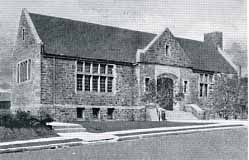
The library was constructed from sandstone which was quarried locally in Beaver County. Inside are large leaded glass windows and the circulation desk and all the shelves are made of oak wood. To the right of the building is a real fireplace set in an alcove. On either side of the fireplace, facing each other, are two wooden benches with small leaded glass windows above each of them.
In September of 1916, the library opened with Miss Marie Murphy serving as the first librarian, being paid a salary of $65 per month.
On June 23, 1919 the school board appointed a committee of citizens, board members, and supervising principal of the schools to become a Board of Library Trustees. Since that time, the growth of the library may be attributed to the cooperative efforts of the Board of School Directors and the Board of Trustees.
The slim budget provided by the school board made it necessary for the trustees to find other sources of revenue in order to develop the library as rapidly as was desired. The records show that they had frequent tag days, benefit movies, solicited donations, etc., in order to purchase more books for the library. The Crucible Steel Company gave substantial donations occasionally which greatly assisted the library. In 1922 the trustees approved a system of renting fictional books on a daily basis. This made it possible to add more books to their shelves. Credit must be given to many citizens who donated books from their own libraries to start the original collection in the Midland Public Library.
Prior to 1929 the large basement room in the library was used for such purposes as Boy Scout, church groups, and civic organization meetings. For about two years, a private kindergarten was conducted by Mrs. F. B. Hill in this room. The Woman's Club of Midland used the library for their meeting place for many years. In appreciation for this privilege, the Civic Club was responsible for beautifying the lawn around the library building and the presentation of many gifts to the library.
During this time it had become necessary to establish a high school library. The high school building was already overcrowded, so the basement room of the Carnegie Library was completely improved with new floors, shelves, lights, and furniture to house the school library.
Today, the basement also houses the reference materials of the library. The fiction and children's collections can be found upstairs.
The initial step in organizing the Rochester Public Library was taken on April 17, 1922 in the Welcome Club, now the American Legion Home. Mrs. Lillian Hurst was named permanent chairman of the library committee. Regular monthly meetings were conducted in the Welcome Club. Publicity and advertising for the new library were used in the press, through church congregations, through the Ministerial Association, through committee members speaking in the schools, essay contests we held. The most active groups supporting the library movement were the Twentieth Century Club and the Woman's Club
By September of 1923, the Library Board was granted permission by the Walter S. Roth Post, American Legion, to use one of their rooms in the library's present location, the corner of Adams and Jefferson Streets. One month later a book reception was held and 600 books were received in addition to financial contributions.
On February 1, 1924 Miss Jesse Wilson, Pottsville, Pennsylvania, became the first librarian. The library was open to the public four days a week.
On April 13, 1925 the library board leased the entire downstairs of the Legion building for a five year period on a rental basis. Following remodeling, the newly enlarged quarters were utilized in June. The Borough Council donated $1,000 to the new library.
In August, Miss Wilson resigned as librarian to accept a similar position in Northumberland, Pennsylvania. Miss Jesse Nesbitt, who had been Miss Wilson's assistant, was named acting librarian.
In November of 1926, Rochester voters approved a one-half mill borough tax for the purpose of financing the work of the library.
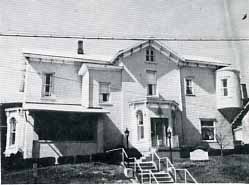
A fire in the Legion building on March 13, 1929 forced the library to move to the vacated Wilson residence on Adams Street, owned by the Grace Lutheran Church. Repairs were made and the library was able to return to the Legion building by November 5, 1929. The Rochester Borough Council purchased the Legion building in April of 1939 and remodeled the second floor to include two apartments. One of the apartments was later made into a storage area for library materials.
The Rochester Public Library, the present site being the property of the borough, is surrounded by lovely trees and shrubbery. Many interior changes have been made through the years. Students of the art classes of Rochester High School donated paintings they made for the children's section of the library.
During more recent years, the Junior Women's Club donated many hours of service and finances. These women assisted the staff in typing catalog cards and initiating a weekly children's story hour which still continues today.
Since the library was established, there have been six acting librarians. The present librarian is Mrs. Earl Cookson, who has been serving since 1965.
The Monaca Public Library had its beginning in the spring of 1934 by the Monaca Junior Woman's Club. The first library was located in the Mullen Building until 1937 when it was moved to the Municipal Building on Pennsylvania Avenue.
The Monaca Public Library consists of one large room with the book shelves located toward the rear. The front of the library has a round table sitting beneath a large picture window which faces the main street. Above the table is a green hanging lamp which gives the library a quaint, homey affect.
When the Monaca Library was organized, many books were donated by interested people of the town and were collected by the Boy Scouts. New books were purchased with funds received through tag days, donations, and benefits. Today there are over 2,000 books in the library.

In 1970, the library was closed to the public. In 1971 interest in re-establishing the library had grown. The Beaver County Public Library Commission agreed to aid in this revitalization process. The Borough Council, along with the new library board, initiated a drive to enlist the support of community leaders and citizens. As a result, the Monaca School Board and Borough Council agreed to support the Monaca Library at a level recommended by the State Library of Pennsylvania in 1972.
The Monaca Library Board rented a remodeled facility at 1018 Pennsylvania Avenue to house the new library. New furniture and books were ordered and the library was opened to the public on a temporary basis in October of 1972. The Monaca Public Library was formally dedicated on January 27, 1973.
The Freedom Public Library was opened on Tuesday, January 24, 1939 by the Woman's Club of Freedom as the civic sponsor and the Freedom Borough Council as the cooperating legal sponsor.
The idea for a free public library in Freedom originated with the Book Club, which was composed of members interested in literature. The Book Club met regularly for two years and its members purchased books for their "dream library." The following year, reading circles were formed throughout the club. Every member of the various reading circles purchased a book. These books were read and exchanged among the club members. It was with these books as a nucleus, that the library was started. Additional books were collected from interested individuals in the community by the Boy scouts.
The Department of Literature in the Woman's Club acted as the Working Library Board with Miss Gertrude Mohr as chairman.
At the April 1939 meeting, the Freedom Borough Council appointed seven citizens to serve as the Freedom Public Library Board.
In the early months of the library, Miss Mohr acted as Supervisor and was assisted by members of the Women's Club. In September of 1939, Estelle Gordon was elected the first full-time librarian, working for nine hours a week for $3.00 per week.
The Freedom Library has grown over the years from a lowly beginning of sixty books to over 11,000 books today. Support has been received from the Freedom Borough Council, Senior and Junior Woman's Clubs, various civic groups, business establishments, many individual citizens as well as County and State aid.
At the December 1938 meeting, the Borough Council voted to provide space for the library, rent free, in the Council room. Soon after that a children's room, young adult room and reference room had been added. In addition, Council furnished the first table, chairs, bookshelves, cash donations, and also pays the librarian's salary and utilities.
In 1939 a wooden sign was placed on the library door made by Charlie Smith at a cost of 75c. This was subsequently replaced with a wooden sign made by Bill "Snuffy" Smith which was placed over the entrance. The present metal sign replaced the wooden one in 1971. Additional furniture added over the years include a bulletin board and magazine rack, moveable book cart, typewriter, table, desk and chair, additional bookshelves, black and white television with cable, juvenile tables and chairs, and a revolving magazine rack.
From the very beginning, various activities have been sponsored by the library. These activities include children's programs, window displays in local businesses, poster contests and a record club for adults and children.
The Freedom Public Library celebrated its 40th anniversary on Monday, April 2, 1979.
In 1941, the Senior Woman's Club of Baden, with the permission of the Baden School Board Directors, started a public library in a room in one of the Baden school buildings. In 1946, the library was moved to two rooms in the Brown Building at the corner of State and Phillips Streets. The library was moved again in 1961 due to crowded conditions. This time it was located in the Economy Plumbing and Heating Company building at 411 State Street. It was named the Baden Public Library.
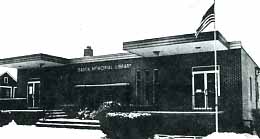
The library continued to grow and none of the other town properties were suitable to house the library with larger quarters. It was then decided to build a multi-purpose building, combining the lower level of the building as a borough garage to house the Borough's heavy equipment, and the street level to be used as the library. The organization of the library became an overall project for the Baden Borough Council, the Building Committee for the library, and all the citizens of Baden.
On August 30, 1971, through the efforts of the Scout Leaders, Boy Scouts, and a number of public spirited citizens, the books and equipment were moved from the Economy Plumbing Building to the new library building, which opened for business August 30, 1971. At this time, the name was changed from the Baden Public Library to the Baden Memorial Library.
Baden Memorial Library is a one story brick building located at 385 State Street. On the outside wall, between the two entrances, is a bronze Honor Roll listing those who died serving their country in World War 1, World War 11, the Korean War, and the Vietnam War. Inside, the library consists of one large room with the book collection located toward the rear of the room, with tables in the center, and the circulation desk near the entrance.
The library' is financially supported by the Ambridge Area School District, Baden Borough Council, Beaver County Public Library Commission, State Aid, and contributions from the citizens of Baden.
For several years, many people felt that the Beaver Area should have a free public library. Members of the Civic Club, together with representatives of other civic-minded organizations in the area, recommended the formation of the Beaver Memorial Library Association and selected a temporary Board of Trustees to organize and establish the Association and the library. Association dues and various club donations provided the foundation of the treasury.
On December 23, 1948 a charter was granted to the Library Association and the school board of Beaver leased a house on its property at the corner, of Fourth and Insurance Streets for one dollar a year. This building was prepared for use almost completely by volunteer labor, with contributions of material from local businessmen.
On November 18, 1949 the library was opened for public use. The Board of Trustees elected Mrs. W. Wallace Rinehart to be librarian and Miss Jean Sebring to be assistant librarian.
Woman's Club members collected and cataloged books and the school district donated the librarian's salary. Boy Scouts, garden clubs and many citizens assisted in preparing the building and grounds.

In 1952, the library became a member of the Community Chest (now United Funds) from which it has continued receiving funds up until the present time. By 1958, conditions became so crowded another community effort was launched, resulting in the New Beaver Area Memorial Library, dedicated on April 8, 1962, appropriately the first day of National Library Week. The new building is located on the corner of River Road and College Avenue.
The brick structure, with wood and steel beam ceilings, houses an open-area type library. Long, full-length windows are lined side by side facing the river and park across the street. Outside, the building is surrounded by a well-kept landscape with a wooden fence and sidewalk leading to the entrance.
Funds for operating and maintaining the library is derived from several sources including the Beaver Area School District, the municipalities, the County of Beaver, gifts, memorials and State Aid.
On November 20, 1964 a committee from the Junior Woman's Club of New Brighton and the Civic Development Association met with Mr. and Mrs. Robert Merrick to discuss the possibility of housing a public library in the first floor of the Merrick Art Gallery. Mr. and Mrs. Merrick were delighted with the suggestion.
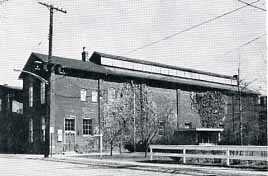
In January of 1965 the first library board was formed and in the spring of 1965 several book drives were conducted by the Junior Woman's Club. Finally, a book collection valued at $10,000 was moved into the library during the summer months. Mrs. Nellie Stafford was hired as librarian in August. She worked twenty hours a week for a salary of $100 per month. Members of the Junior Woman's Club spent many hours helping the new librarian catalog the books.
On October 7, 1965, the New Brighton Public Library was formally dedicated. Open house was held October 8th and 9th and the public began borrowing books on October 11, 1965. Fifty adults and children were registered on this first day.
Although the New Brighton Public Library is a small, one-room facility, materials not found there can still be obtained through the County's District Center Library in Aliquippa.
The idea of establishing bookmobile service for Beaver County was suggested as far back as 1965, prior to the establishment of both the Beaver County Public Library Commission and the Beaver County Federated Library System. In 1965 the Health and Welfare Council of Beaver County conducted a study of the public libraries and published a report entitled, "Public Library Services in Beaver County; A Financial and Organizational Study." This report recommended that bookmobile service be established in this county in order to expand and extent library services. Estimated initial and first-year costs totaled $77,000.
The Public Library Commission, established in 1971 by the Beaver County Commissioners, is responsible for developing both short and long term plans for library services which will satisfy the needs and demands of all county residents.
In 1973, the Library Commission developed a five to ten year plan of service for future operation. Based on this plan of service, the Commission devised a list of priorities for future county-wide programs and services. Of the several priorities established in August of 1974, the number one priority was a "mobile outreach program using a delivery van with a small collection or purchasing a bookmobile to extend services to currently unserved or inadequately served areas."
In early 1975 the Library Commission began to gather information concerning the costs of initiating and maintaining a book mobile service. A survey was conducted throughout the county to determine whether or not expanded services of this nature were needed. After the results of this survey were obtained, a definite need for bookmobile service was expressed.
Funds for the bookmobile project were received through a Library Services and Construction Act, Title 1, grant totaling $32,675. Provisions were made in the Library Commission's 1975 operating budget for partial payment of the vehicle to be used as the bookmobile. An account for the purchase of library materials was also set up with the Baker and Taylor Company.
By 1976, three positions were filled for the Beaver County Traveling Library: a librarian, a clerk assistant, and a driver/clerk.
July of 1979 marked the third anniversary of the bookmobile. Since its conception, the traveling library has gone from the initial 29 stop schedule to its current schedule of 39 stops. The bookmobile's book collection has grown from 5,066 volumes to over 12,000 volumes. Circulation increased from 13,999 in its first years to 39,427. The bookmobile has been a successful project in serving the patrons of Beaver County in their library needs.
BEAVER COUNTY PUBLIC LIBRARY COMMISSION, ALIQUIPPA In 1971, after a major study was conducted on the financial condition of all of Beaver County's libraries, the Beaver County Commissioners created the Beaver County Public Library Commission. The purpose of this commission was as follows:
1 . Develop sound policies and coordinate library services
2. Examine and review existing library services in the county
3. Assign both general and specific roles and responsibilities to existing libraries
4. Provide financial assistance to support the individual library's assigned functions
5. Spell out conditions and terms for library participation in the system
6. Measure the progress and growth of library operations as outlined in the contracts with individual libraries
7. Determine the extent of financial assistance to be rendered for system participation
8. Provide the stability and incentive to establish quality library services for all residents of Beaver County
The Director of the B. F. Jones Memorial Library in Aliquippa (the District Center Library) was employed as library coordinator for the county system. By December of that year, all the county libraries had signed special contracts and had affiliated with the newly created Federated Library System. As the year 1972 opened, it was announced that library services would be available to all residents of Beaver County.
Over the years, the Beaver County Federated Library System has carried out the policies that were arranged, plus a measure of financial assistance has been provided to support the individual libraries in their assigned functions. An effective public relations program has been developed and implemented. Books are brought to those who live outside the service areas of the various libraries by the bookmobile. There is van service three times a week to transport library materials and other needed items to many of the county's libraries. In addition, there are various services such as story hours, system collections development, publications of bibliographies and the like that have been provided by the system staff.
Under this system, along with each library's individual efforts, Beaver County residents can be proud of the services provided by Beaver County's libraries.